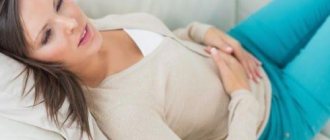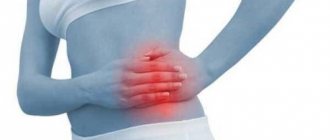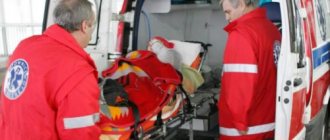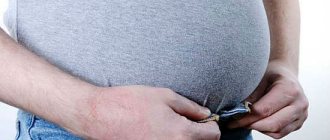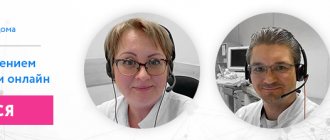Stitching pain in the left side under the ribs is not a sign of any separate disease. The pancreas and spleen are localized in this part of the body; heart pain can be felt; the left wall of the stomach and the left part of the diaphragm are located here.
Algia may affect the left kidney and ureter. And which of these vital organs signals a problem in the body can only be determined by a specialist, based on anamnesis and subsequent examinations. But first you need to decide what types of pain are typical for the left hypochondrium, and what diseases each of you may encounter when experiencing discomfort in this part of the body.
How to determine the cause of pain based on symptoms
The table was compiled by Victoria Druzhikina, a practicing therapist on the website Ask the Doctor.
| Disease | Symptom | Drugs used |
| Ovarian cyst, oncology, adnexitis | The pain is often dull and of moderate intensity. Cycle disturbances, bleeding of varying severity. | Antispasmodics (“No-shpa”, “Papaverine”); "Magnesia"; Hormonal therapy; Surgical intervention. |
| Endometriosis | The pain is quite intense and is accompanied by cycle disruption and bleeding. | Surgery; Hormonal drugs. |
| Ectopic pregnancy | Severe pain, sometimes to the point of loss of consciousness, bleeding, delayed menstruation, nausea. | Surgical intervention. |
| Pancreatitis | Most often dull, aching, paroxysmal pain, intensifying after fatty foods, rarely severe, loose stools | Antispasmodics (“Duspatalin”, “No-shpa”, “Papaverine”); Antacids (Famotidine, Omeprazole, Rabeprazole) |
| Enterovirus infection | Sharp, cutting, cramping pain, nausea, vomiting, very frequent loose stools, fever. | Antispasmodics (“No-shpa”, “Papaverine”); "Ibuprofen", "Paracetamol". |
| Gastritis, reflux | Pain of varying degrees of intensity, intensifies with food intake, and also occurs on an empty stomach. Nausea, heartburn, belching. | Antispasmodics (“No-shpa”, “Papaverine”); Antacids (“Almagel”, “Phosphalugel”); Proton pump inhibitors (Pantoprazole, Omeprazole, Rabeprazole). |
| Stomach ulcer | Acute, severe pain, nausea, cold sweat, severe weakness, and possibly fainting. | Narcotic analgesics (Morphine); Surgical treatment; Antispasmodics (“No-shpa”, “Papaverine”); Antacids (“Almagel”, “Phosphalugel”); Proton pump inhibitors (Pantoprazole, Omeprazole, Rabeprazole). |
| Appendicitis | Many faces - pains are sharp, dull, strong, weak, from the navel to the level of the sternum. Nausea, single vomiting. Fever. Loose stools. Mixing of pain from the epigastrium to the right iliac region after 3–4 hours from the onset (Kocher’s symptom). | Surgery |
| Duodenitis, ulcerative colitis | Aching or cramping pain along the intestines, rumbling in the stomach, bloating, blood, mucus in the stool. The stool is irregular, liquid. | Antispasmodics (“No-shpa”, “Papaverine”); Antidiarrheal (“Smecta”). |
| Bowel cancer | The pain is aching at first, then severe. Constipation, obstruction, weight loss. | Surgical treatment, chemotherapy, radiation |
| Nephroptosis | Pain is often associated with sudden movements, especially high jumps, and prolonged standing. Most often dull, less often intense. High blood pressure, fatigue, loose stools. | Surgical correction – kidney suturing |
| Osteochondrosis | The pain comes from the spine and intensifies with movement, inhalation, and coughing. At rest they subside or decrease. | NSAIDs (“Meloxicam”, “Xefocam”, “Diclofenac”, “Aertal”); Muscle relaxants (“Sirdalud”, “Mydocalm”); Chondroprotectors (“Teraflex”, “Dona”, “Arthra”); B vitamins (“Neurobion”, “Combilipen”, “Milgamma”). |
| Bruise, injury | Pain is associated with a fall, blow, etc., and is limited by this impact. Intensifies with pressure. Accompanied by the formation of a hematoma and bruise. | NSAIDs (Meloxicam, Xefocam, Diclofenac). |
| Myositis | Pain in the muscle, intensifies with pressure and movement. Quite noticeable, subsides when resting. | NSAIDs (“Meloxicam”, “Xefocam”, “Diclofenac”, “Aertal”); Muscle relaxants (“Sirdalud”, “Mydocalm”); |
| Pyelonephritis, ICD | The pain is intense or dull, intensified by tapping on the lower ribs from behind. Urine is cloudy or red. | Antibiotics (“Ciprofloxacin”, “Levofloxacin”); Antispasmodics (“No-shpa”, “Papaverine”); Analgesic (“Baralgin”); Herbal antiseptics (“Lingonberry leaf”, “Canephron”) |
Clinical manifestations of pathology
The disease is characterized by the appearance of such typical symptoms that allow one to immediately suspect chronic gastritis:
- Heartburn is the appearance of discomfort and a burning sensation in the area behind the sternum. It may worsen when bending forward or in a horizontal position, when acidic gastric juice refluxes into the lower parts of the esophagus.
- Pain in the stomach area, namely in the epigastric region and in the upper parts of the left half of the abdomen. Most often they are aching or spastic in nature and occur 20-40 minutes after eating, which depends on the location of the inflammatory process.
- There is an unpleasant odor from the mouth and frequent severe belching that occurs after eating.
- Nausea almost always accompanies pathological changes in the stomach; in some cases, vomiting may occur.
- The abdomen is swollen, painful in the upper sections. The properties of the stool also change, most often towards constipation.
Diagnosis is based on the collection of complaints, an objective examination of the patient (pain in the abdomen in the projection of the stomach, a thickly coated tongue, a strong odor from the mouth) and data from fibroesophagogastroduodenoscopy (FEGDS). Treatment involves following a diet (table No. 1), taking antacid medications and, if necessary, carrying out eradication therapy against Helicobacter with a number of antibiotics.
Description of the main diseases for pain in the left side
Gynecological problems in women
The elements of the pelvic region in women are fraught with very complex processes. The work of the reproductive system is cyclical. At each stage of the cycle, important changes occur (maturation of the egg, its release into the fallopian tubes, ovulation, conception or extinction of the corpus luteum, endometrial rejection). All these moments may be accompanied by slight discomfort in the lower abdomen (sometimes extending to the waist area) on the left or right. This may be a pulling sensation or slight tingling in the left or right side. In this case, this is the limit of the norm. But if there is real paroxysmal pain, then we are most likely talking about pathological processes.
Pain in the left lower abdomen in women is sometimes recorded with the following gynecological problems:
- cystic cavities, polycystic left appendage;
- endometriosis;
- ectopic pregnancy;
- threat of self-abortion (during pregnancy);
- left-sided adnexitis;
- oncological tumors localized in the left area of the reproductive system (an additional consultation with an oncologist is prescribed).
Diagnosis and treatment
If you suspect problems in gynecology, you should definitely seek advice from a specialized specialist. At the first appointment, as part of the examination, the patient is interviewed for suspicions and complaints, examined on a gynecological chair with the collection of material (smears) for flora and histology. Then, the woman is given a referral for an ultrasound scan of the pelvic organs and, if necessary, the mammary glands.
Based on the initial examination, the doctor determines the diagnosis and prescribes therapy or refers the patient to a comprehensive examination (blood test for hormones, OAC, OAM, etc.). If gynecological problems are not identified during the diagnosis, the woman is advised to consult a specialist of another profile (if diseases of other organ systems are suspected).
Moderate stabbing, pulling discomfort is often recorded with premenstrual syndrome. This may be the norm, but sometimes it indicates a sluggish inflammatory formation in a given area. If you have similar symptoms, you can contact a specialist and gynecologist online.
Stomach, intestines and pancreas
Stitching, cutting, dull pain in the side (lower abdomen or waist area) occurs in women suffering from gastrointestinal disorders and ailments. If we are talking about the stomach and pancreas, then the pain syndrome is usually localized in the upper left part of the abdomen, at the waist level and slightly below. Sometimes the pain radiates to the back or is felt closer to the middle of the peritoneum. The intestines give pain on the left side below or above. Discomfort is sometimes acutely felt below, but often radiates throughout the entire circumference of the abdomen and is found in the back.
Pain syndrome in the left side is recorded with the following gastrointestinal problems:
- peptic ulcer of the intestines, stomach, duodenum;
- gastritis (effective tablets for stomach pain are described here);
- duodenitis;
- pancreatitis;
- dysbiosis of the intestinal walls (the causes of frequent diarrhea are described here);
- acute enterovirus infection;
- vaginitis;
- atypical ulcerative colitis;
- oncology (oncologist consults);
- reflux esophagitis.
You need to understand that pain in the left hypochondrium at the waist or lower abdomen is often not at all associated with serious illnesses.
For example, after eating fatty, spicy or too heavy food, the digestive system may experience a one-time temporary failure in the form of pain in the lower abdomen or at the waist level on the left.
Diagnosis, therapy
If you suspect gastrointestinal diseases, you should make an appointment with a gastroenterologist. The doctor will conduct a survey and prescribe tests. As a rule, as part of a gastrointestinal examination, the following is carried out:
- examination of the epigastric region using ultrasound scanning;
- gastroscopy (if gastric and duodenal ulcers are suspected);
- scraping on the bacterial environment from the gastric mucosa in order to isolate the bacterium Helicobacter pylori.
As an additional examination of the patient’s condition, a diagnostic assessment of blood and urine is prescribed. In some circumstances, radiographic examination is sometimes performed. When diagnosing gastrointestinal diseases, the entire symptomatic picture is taken into account. In addition to pain in the left side (lower abdomen or at waist level), diseases in women may be accompanied by additional symptoms:
- belching, heartburn, hiccups (therapy is carried out by a gastroenterologist);
- hyper and hypothermia of the body;
- vomiting, flatulence, stool disorder;
- apathy, loss of appetite.
Treatment of gastrointestinal diseases in some cases is carried out with medication, in other situations it requires surgical intervention. Depending on the nature and severity of the disease, outpatient or inpatient treatment is prescribed. Many problems of the digestive system become chronic and require constant compensation therapy.
A consultation with a gastroenterologist will help you deal with the problem in the abdominal area.
Pyelonephritis, dilatation of the renal pelvis, other ailments
Diseases of the urinary system can also cause pain localized in the left lower or upper side. An inflammatory process in the ureters, kidneys or urolithiasis in women can cause pain. With urolithiasis, pyelonephritis, and chronic renal failure (chronic renal failure), the discomfort is acute and pronounced. With mild inflammation, the attacks are weak, barely noticeable, aching. In case of kidney diseases, discomfort is mainly concentrated in the back area at the waist level. However, often aching, stabbing sensations spread to the side, as well as to the front. If the left kidney aches or the ureter in this area is inflamed, pain can be felt in the left side at waist level or slightly lower (at the level of the navel).
In the photo: localization of attacks of pyelonephritis
Diagnosis and treatment
If there is pain on the left side, and symptoms such as swelling, frequent or infrequent urination, pain when emptying the bladder are observed, you should consult a nephrologist or urologist. As part of identifying the cause, the patient will be prescribed an ultrasound of the kidneys and bladder, urine tests according to Nechiporenko, Zimnitsky and a general, general clinical and biochemical blood test. Based on the test results, the doctor makes a conclusion and creates a treatment algorithm. If the examination shows results that are insufficient to make a final diagnosis, or analyzes and tests indicate the absence of problems in this area, the patient may be sent for further examination or referred to a specialist of another profile.
Nephropotosis (prolapse of the kidney)
Nephroprotosis is prolapse of the kidney. The condition may be congenital or acquired due to injury or significant weight loss. May develop during pregnancy. Due to increased mobility, the organ is lower than it should be, and therefore often causes discomfort. There are: Fixed nephroptosis. The kidney is lowered and completely fixed. A wandering bud. In this case, the organ easily moves and changes location. Painful sensations can vary in severity, often dull, less often intense, and occur when jumping, turning around its axis, sudden movements, or standing for long periods of time. They can radiate to the groin and thighs. Other symptoms:
- nausea;
- loose stools;
- increased gas formation;
- decreased performance;
- Bad mood;
- increased blood pressure;
- blood in urine.
The diagnosis and confirmation of pathology are based on kidney ultrasound, contrast urography, and MSCT. Treatment can be conservative and surgical. In the first case use:
- kinesiotherapy;
- exercise therapy;
- bandage;
- a diet with a sufficient amount of kilocalories - the fatty tissue in which the kidney is located cannot be lost.
The operation is performed when the kidney has descended below the 4th lumbar vertebra, there is severe pain, uncorrectable hypertension, and there is no effect from conservative measures. Its essence is fixation of the organ in a physiological position.
Appendicitis
Pain in the left side of the lower abdomen sometimes indicates damage to the appendix (cecum). This is more the exception than the rule. The cecum is attached to the lower right side of the abdominal cavity. With appendicitis, the syndrome is mainly localized in the right side and extends to the left side. This is acutely felt when the patient is tested by palpating the right lower peritoneum or is asked to roll over to the opposite side. In these cases, the sensations seem to “transition” to the left lower side (down the abdomen). But in some situations, a clear pain syndrome with appendicitis is recorded precisely in the lower left side.
Doctor's advice
Pain in the left side can be caused not only by ovulation, but also by menstruation due to severe spasm of the uterine muscles. In such cases, there is a clear connection between the onset of menstruation and pain. Therapy is prescribed by a gynecologist.
Victoria Druzhikina Neurologist, Therapist
Defining the problem and solving it
If there is a slight or strong suspicion of inflammation of the appendix, you should immediately call a doctor or go to the emergency room of a hospital. When a diagnosis of appendicitis is made, surgical treatment is almost always required. Delay in this case is dangerous. Untreated appendicitis can develop into peritonitis, a life-threatening complication.
To more accurately determine the symptoms of appendicitis, you can consult a surgeon or therapist.
Other causes of pain in the left side
Women may have pain on their left side for other reasons not described above. An example is the following list of ailments in which unpleasant sensations can be partially or completely localized in the upper left (at waist level) or lower side (lower abdomen):
- mesadenitis;
- intercostal neuralgia;
- bruise, damage to soft or bone tissue;
- parasitic infestations (worms);
- food poisoning;
- infectious diseases (dysentery, acute respiratory infections, etc.) - treated by an infectious disease specialist;
- oncological diseases;
- enterocolitis.
The causes of pain in any side can sometimes be very unexpected. For example, it is difficult for a person without medical education to guess that acute or aching syndrome on the left sometimes indicates lung diseases (pleurisy, tuberculosis, cancer).
Sometimes pain in the left hypochondrium is the result of inflammation of muscle tissue (myositis). In this case, a neurologist will help, visceral therapy will help relieve spasms and correct muscle tension.
If it aches, pulls, or stings in the side in question, but what it looks like is difficult to determine, you should consult a therapist. The general practitioner will listen to the patient and conduct simple tests and examination. Next, the woman will be given a referral to a specialized doctor, whose competence is to diagnose the disease that the therapist suspects.
Briefly about diseases and organs located on the left side of the body
Diaphragm and its pathologies
The diaphragm is the muscle tissue that separates the breastbone from the gastrointestinal tract. It, too, with age, various disorders arise, for example, a hernia. This membrane has an opening through which the esophagus passes and connects to the stomach. And when the muscle tissue of the diaphragm weakens, the lumen increases slightly, as a result of which the upper part of the stomach protrudes into the thoracic region. This causes stomach contents to back up into the esophagus, causing heartburn, nausea and pain on the left side. This condition can be caused by obesity, excessive physical activity, and pregnancy.
Diaphragmatic hernia, as this condition is called, occurs in older people due to weakening of muscle tissue. Sometimes the stomach becomes pinched, which causes sharp cutting pain on the left.
Intercostal neuralgia
Intercostal neuralgia appears as a result of compression of nerve endings.
Intercostal neuralgia occurs due to compression of the nerve endings located between the ribs. Pain can be expressed in a wide range of manifestations: from sharp and piercing, to burning, or aching, dull. It increases with physical work, coughing, sneezing, even inhaling.
Sometimes attacks of thoracalgia are accompanied by muscle tremors, redness or paleness of the skin, and sweating. Pressure on certain points on the back also causes pain, which can radiate to the lower back or under the shoulder blade. Pain with intercostal neuralgia is similar to that that occurs with cardialgia.
Heart diseases
Heart disease is usually accompanied by aching discomfort, shortness of breath, sometimes nausea, increased heart rate, heaviness in the chest and a burning sensation. These symptoms indicate coronary heart disease, which occurs as a result of impaired blood flow to the heart muscle due to damage to the coronary vessels. Such pain may also indicate cardiomyopathy - dysfunction of the heart muscle due to structural distortions of the organ, and this is expressed by increased fatigue, cardialgia during physical activity.
Frequently asked questions and doctor's answer
General practitioner Victoria Druzhikina answered questions
When I cough, my left side hurts under my ribs. - “The connection with coughing movement occurs with myositis, osteochondrosis, pancreatitis, pleurisy.”
Lying on the right side, the left side hurts. - “Possible options are pleurisy, ulcer, bruise, ulcerative colitis, urolithiasis, ovarian cyst.”
Lying on the left side, the right side hurts. – “May be a symptom of appendicitis, nephroptosis, myositis. Consultation with a medical professional is required."
My left side hurts and I feel nauseous. – “If there is a connection with food intake - pancreatitis, duodenitis, gastritis, ulcer. If the temperature and loose stools are parasites, enterovirus infection. Temperature with normal stool – MBC, pyelonephritis. The presence of a cough may indicate pleurisy."
My left side hurts when walking . – “Most often, pain when moving is caused by muscle function (myositis), pathologies in the spine (osteochondrosis) or ribs (bruise, fracture). Less often, the cause lies deeper - nephroptosis, urolithiasis, pleurisy.”
My left side hurts when running. “This occurs in almost everyone who does not run or play outdoor games professionally. Before exercise, the muscles need to be warmed up, otherwise they will hurt from overexertion. It can also be a symptom of nephroptosis, urolithiasis, ovarian cyst.”
My left side hurts after eating. – “A sign of chronic pancreatitis, gastritis or ulcers. If pain occurs after physical activity following a meal, this indicates insufficient time allotted for the digestion process. Before training or doing anything active, you need to wait 2 hours after eating.”
After eating, the left side under the ribs hurts . “The association with food intake indicates involvement of the digestive system. This is how gastritis, pancreatitis manifests itself, and, less commonly, ulcers and duodenitis.”
The back left side hurts . - “It can be pancreatitis, pyelonephritis, osteochondrosis, myositis, ulcer.”
During pregnancy, the left side in the lower abdomen hurts . “When carrying a baby, a woman’s body faces increased stress, including on internal organs. Such symptoms are possible with irritation of intestinal loops, cystitis, pyelonephritis, and compression of the ureter. But this may be a threat of miscarriage, especially if there is bleeding. In any case, there is no need to take risks - you should immediately consult a doctor.”
The left side hurts under the ribs in front . – “This can signal an inflamed pancreas, oncology, duodenitis, myositis, gastritis, ulcers. Sometimes this is how myocardial infarction manifests itself. The best way out in such a situation is to be examined by a medical professional.”
Signs when to call an ambulance
Abdominal pain is an alarming symptom that often requires immediate examination by a medical professional. You need to call an ambulance in the following cases:
- severe, sharp or acute pain occurred suddenly, against the background of complete health;
- increased temperature;
- blood or mucus in stool;
- the patient feels an exacerbation of chronic pathology, which is severe;
- lack of stool and gas;
- lack of urine with preserved or absent urge;
- blood in urine;
- dyspnea;
- cold sweat;
- fainting state.
When should you go to the doctor?
Discomfort in the abdominal cavity on the left almost always requires attention. You can ignore the pulling, aching sensation in the side at waist level only if this moment is associated with an awkward movement, muscle overstrain, or strain. If the syndrome quickly disappears and is not combined with other symptoms, you can relax and not go anywhere.
But if the pain on the left (lower abdomen or at waist level) is constant and/or pronounced, combined with other signs of various ailments, you should definitely see a doctor. This is necessary to determine the cause of discomfort, as well as to prescribe the correct treatment if a disease is detected.
Useful articles on the topic: Pyelonephritis in women: causes, classification, symptoms and treatment Kidney disease in women: symptoms, diagnosis and treatment Polyp in the intestines What can be taken for stomach pain: a review of medications
This article has been verified by a current qualified physician, Victoria Druzhikina, and can be considered a reliable source of information for site users.
Rate how helpful this article was
4.3 56 people voted, average rating 4.3
Did you like the article? Save it to your wall so you don’t lose it!
Mechanism of formation of abdominal pain
The feeling of pain serves as a protective reaction for the body. It indicates damage and requires help. According to the mechanism, pain impulses can be formed by:
- spastic contraction or hyperextension of hollow organs (intestines, stomach, bladder and ureter);
- an ulcerative process that violates the integrity of the submucosal and muscular layer (there are no pain receptors in the mucous membrane itself);
- stretching or rupture of the capsule of parenchymal organs (spleen, kidney);
- damage to nerve branches and plexuses (due to rib fractures, inflammatory processes, tumor disintegration).
Spastic pain is difficult for patients to tolerate
The classification of pain includes the following types:
- organ - caused by damage to one or more organs by inflammation, ischemia (reduced blood flow through the arteries), infectious process, pain in the left side of the abdomen migrates, does not have an epicenter and precise localization;
- parietal - connected to the abdominal wall, clearly localized at the site of the lesion;
- neurogenic - caused by damage to nerve fibers, distortion of the impulse to the brain, the organs themselves lying in the abdominal area may not be damaged;
- reflected - projected onto a zone that is connected by the location of the nerve ganglia of the spinal cord.
Pathology of the abdominal organs is caused by a mixed mechanism. One violation leads to a chain reaction. Knowledge of the combined negative process allows you to select the optimal treatment to counteract and reduce pain.
